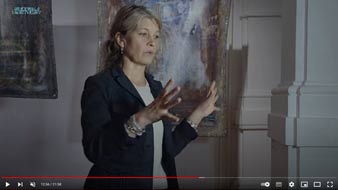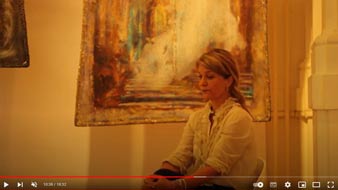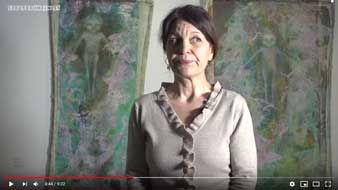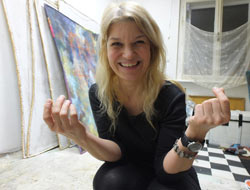INTERVIEWS & TALKS (slo)

video: Natalija Šeruga Golob: From the Collection of W. B.: Protocol of the same experiment from (…), t. s. (test subject) Avgusta, MMC KIBLA/KiBela, Maribor, Slovenia, 2023.,
Published on October 29, 2023. (CONTEMPORARY ART - www.youtube.com/@SODOBNAUMETNOSTCONTEMPORARYART)

video: Natalija Šeruga Golob: From the Collection of W. B.: Protocol of the same experiment from (…), t. s. (test subject) Avgusta, MMC KIBLA/KiBela, Maribor, Slovenia, 2023.,
Published on December 11, 2023. (KID KIBLA - www.youtube.com/@KIDKIBLA)

video: Natalija Šeruga Golob: Salve Regina III, CONTEMPORARY ART,
(Platform for Contemporary Art, Life and Risk)
Published on March 2, 2019
In video Natalija Šeruga Golob is talking about her artwork
Salve Regina is a piece of art which I have been knitting for the last three years. It is the third in the series of three. The Installation in the City Gallery in Nova Gorica has opened me the door into something new and I am hardly waiting to return to my studio.
Firstly, I would like to point out that verbal and visual never correspond. My talk can take you completely somewhere else than Salve Regina is supposed to take you.
If the process of thinking is being weaved, I would like to weave some threads here.
The first thread is the thought of the famous art theorist James Elkins who stated a bold thesis: “Not the words and thoughts about paintings are important, but are the thoughts and words on the process of creating.”
The second thread has for ever been with me, which I articulated when I met a thinker Walter Benjamin. He speaks about aura of paintings. But I was even more attracted to his idea that paintings had never been meant to be simultaneously observed by the crowd but by one or only a few observers. Until the first crisis of painting in the 19. century paintings had been at home in churches, manors, castles, where the access to them was not allowed to everybody, it was hierarchical, and were not exposed at all time.
The next, the third and the most important, the main thread is childish anger, sadness, but today it may be related to unconditional surrender, capitulation to the great force, which eternally gives and takes and like it is on carousel, on which we are so and so for a short time, and it kicks us out whenever it feels like. And together with my favourite poet Walt Whitman I am singing a hymn to this force, it is a hymn to death.
The following is thread of cemeteries. Recently I have found fabulous beauty, which is even more than beauty, in the large, old city cemeteries. Not being only a beauty, but something more, is imprinted in me and accompany me to my studio. And therefore returns to Venice are unavoidable.
After all, comes my favourite thread: coloured pencils. I mean painting pigments, which enables me to create something I am not able to create with my head and conscious, painting material and coincidence carry out much better and even more deeper than I could have been bold to imagine.
So, those are the threads, there are even more than these, let it stay like it is.
The title Salve Regina was chosen because the words firstly sound and then they mean. Salve Regina firstly sounds beautifully and then it means exactly what I was looking for.
Let me salute the force; Walt Whitman says that he sings a hymn to death, so Salve Regina is a hymn.
Salve Regina is composed of a few segments. One presents paintings named Shrouds, large-scale sawn canvases, then, there are small-scale paintings named Mirrors, made on ordinary meaningless wooden frames. At the very beginning I knew that I would not hang them on the wall, but lie them down on the medieval reading shelves or to pews. These pews were made by my father, according to my instructions. And they remind us of what they remind us. And small paintings lie on them. They were created by the same key as the big ones. Of course, the process of creating is conditioned by the size of painting.
Recently, I have been creating small paintings on the old book covers, with wax and pigments. On this exhibition these paintings are in emptiness. I started these paintings in the year 2013 and some of them were successfully finished in summer 2018, with the same approach regarding the content and the process.
One segment of the installation Salve Regina is also a video Salve Regina. I filmed the video one beautiful autumn day in the main square of Palmanova, with white sand and white sky... And while I was looking for a carousel I didn’t find it. And then, by the way, I stopped and recorded the video. Again coincidence, when you look for and want something, things do not come. However, without searching for there is no coincidence, either.
I am a painter, classical painter and in the very beginning I recognized that nowadays, common canvas carrier on wood frame is not for me. So more than twenty years ago I started looking for the right painting carrier which would remind of something old, which would be associated with something old. My wish was to trigger associations with the core and the archaic.
At the moment of sewing canvas, I am 40.000 years ago, creating a shelter protecting me from cold and wild animals, while today I am sewing the shelter from the banality of everyday. And before I start, such a carrier takes me somewhere else, opening the further path.
Once again, verbal and visual never correspond, it is important what and how something is done. The answer to “What is visible?”. It is truth that a figure appears on the paintings and it is being transformed. The form in which it is at the moment is a result of one kick. Years ago, I was angry and furious after hearing that my figures are schematic. At the end, I recognised that this anger was coming out from my inner, deeper knowledge, that my figure in that phase wasn’t the best one. However, I have persistently worked on figures. I have to point out again that material makes figures better than me. They are made by material and coincidence.
Natalija Šeruga Golob, February 2019

Natalija Šeruga Golob in her studio, 2016
(photo: Maja Škerbot)